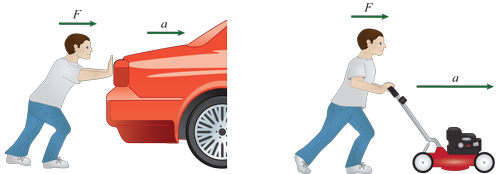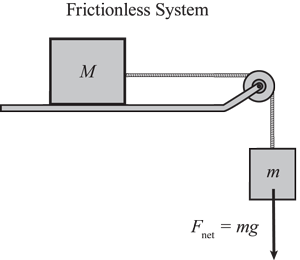Module 2 – Newton's Second Law
Introduction
You have learned that all freely falling objects fall at the same rate, but that the force on any one object depends on its mass. This is because more massive objects require greater force to be accelerated the same amount as less massive objects. This is not hard to understand. It takes more push (force) to get the heavier car to accelerate than it does the less massive lawn mower.
Figure 1
Modified Atwood Machine
Take a good look at Figure 2 below. Let's apply Newton's Second Law to this machine. Remember that the Second Law can be written as follows: or
Figure 2
Condition 1: Fnet = mg
Condition 2: a =
| Fnet |
| (M + m) |
Acceleration Revisited
Take a good look at equation 3a =
.
for the system's acceleration again. Let's study the acceleration when we vary the masses.
| mg |
| (M + m) |
M = 0 kg
When you remove the mass on the table, equation 3a =
.
yields a = g. This is just the case we have for free falling objects. The hanging mass is not restrained by the mass on the table, so it will fall freely.
| mg |
| (M + m) |
M is larger than m: M = 2 kg; m = 1 kg.
When the mass on the table is twice as massive as the hanging mass, equation 3a =
.
yields a = (1/3)g. This makes sense too. The weight of the hanging mass is required to move three times the mass, so the acceleration is reduced to one-third the value. If you increase the table mass to 99 times the hanging mass, the acceleration becomes a = (1/100)g. When friction is introduced, the system is stationary, but without friction, the rate of fall is reduced significantly.
| mg |
| (M + m) |
M is smaller than m; m = 2 kg; M = 1 kg.
When the hanging mass is twice that of the mass on the table, equation 3a =
.
yields a = (2/3)g. In this case, notice that the system accelerates more quickly than the case when table mass was larger, but not as quickly as in free fall. As you increase the hanging mass, the acceleration of the system will get closer and closer to g. When the hanging mass is 99 times the mass on the table, the rate of fall will be (99/100)g or 0.99g.
| mg |
| (M + m) |
Procedure
This experiment consists of three parts.1
Open the experiment instructions and worksheet.
-
•Newton's Second Law Experiment Instructions (HTML or PDF)
-
•Newton's Second Law Experiment Worksheet
2
After you have thoroughly read the instructions and worksheet, open the experiment simulation in which you will conduct the experiment and collect your data.
3
Record your data in the worksheet. (You will need it for the lab report assignment in WebAssign.)
